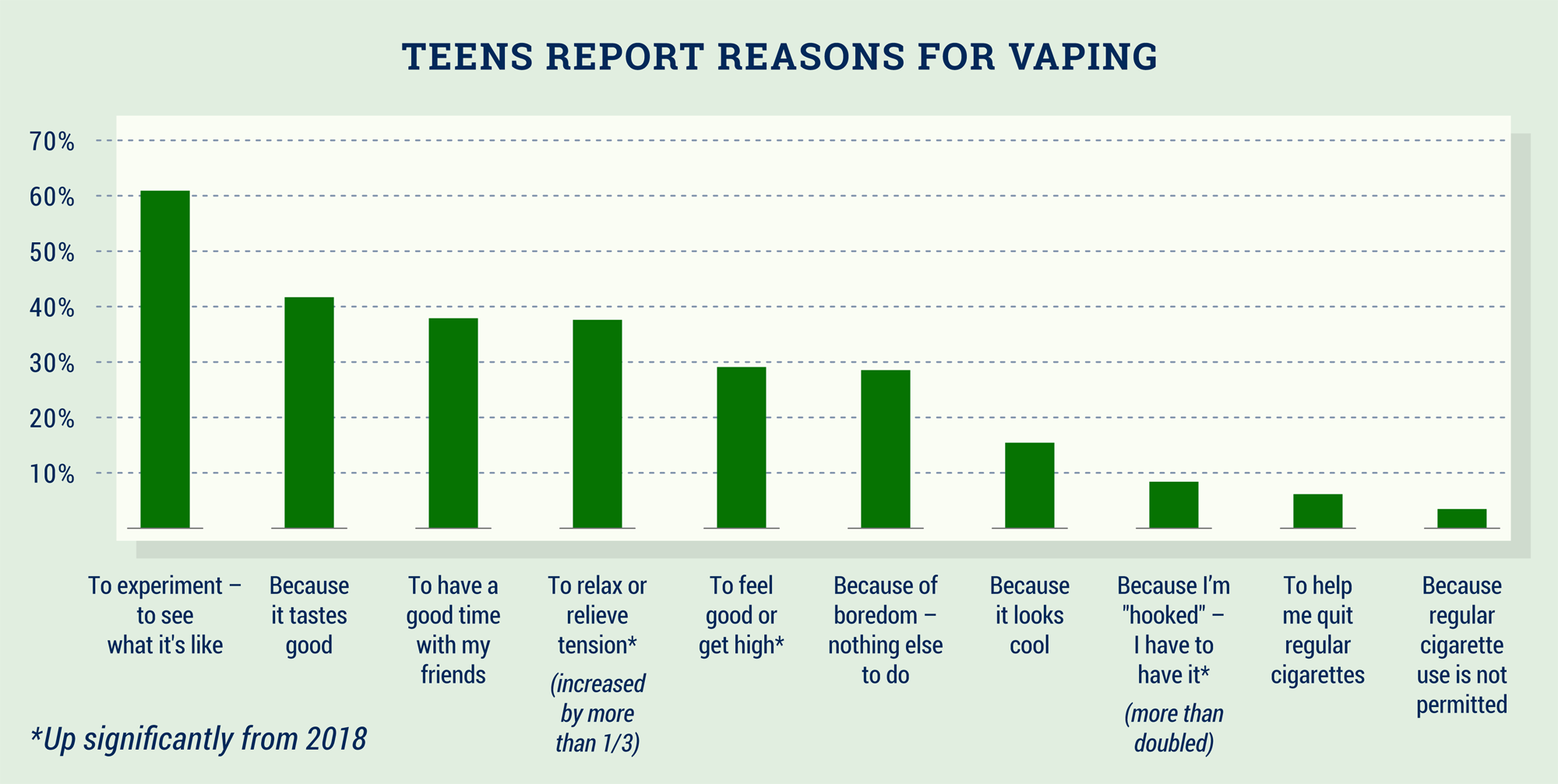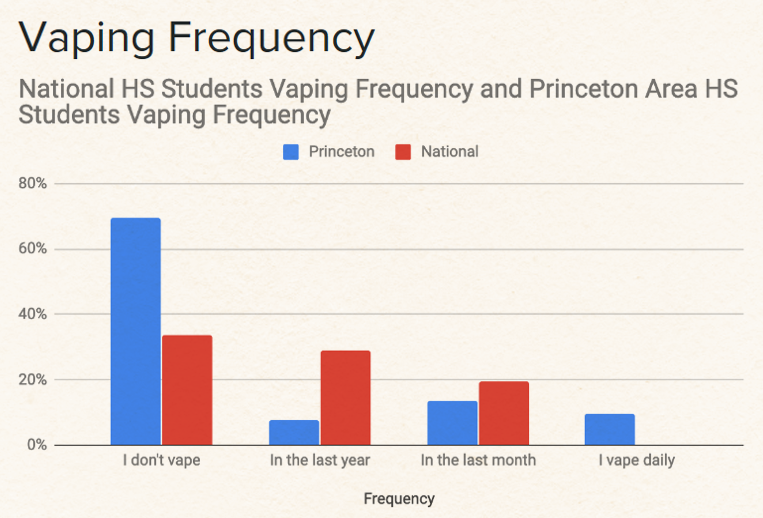Vaping has become dangerously prevalent amongst teenagers. The temptations for Princeton teens are no different than others, but is the forecast for vaping use in our local high schools more optimistic?
Teens vape for many reasons. Teenagers want to be part of a group and are heavily influenced by their peers. They also want to experiment and have fun. In this regard, vaping seems to be an attractive option for many. In today’s world, being a teen can be challenging and stressful. Too many teens have not developed healthy coping skills, and resort to unhealthy coping mechanisms such as vaping, drinking or abusing drugs.
What is Vaping?
Vaping is the term for the act of inhaling and exhaling an e-cigarette(1). A battery in the e-cigarette heats a solidified liquid that contains flavoring chemicals, propylene glycol, glycerin and usually nicotine, producing an aerosol that is inhaled into the lungs and then exhaled. Many of the chemicals used in this mixture are toxic and dangerous. Vaping produces no fire, ash or smoky odor.
The most popular brand of e-cigarettes is Juul and it is marketed as an alternative to smoking. The Juul device resembles a USB flash drive and attracts young teen smokers with appealing flavors such as crème brûlée, mint and mango. A single Juul contains around the same dose of nicotine as one pack of cigarettes. The FDA recently issued a ban on most flavored vaping products, except for tobacco and menthol (as those flavors are less appealing to teens).
Teen Vaping
The brain’s peak period to develop addiction is in adolescence. Because the brain continues to develop into a person’s mid-20’s, exposure to any addictive product, such as nicotine and THC (liquid THC is an ultra-concentrated marijuana that has been extracted from buds and processed into the form of a vape juice that can be inhaled at low temperatures with a vape pen, or any other type of concentrate vaping device). During this sensitive time, changes in the structure and function of the brain and make it more susceptible to addiction and use of other addictive substances. Vaping is a very popular activity among young people. A national 2018-2019 survey by “Monitoring the Future” showed an increase in teen vaping(2). This was the second largest one-year increase ever tracked for any substance in their 45-year survey history (nicotine vaping showed the largest increase from 2017-18). The survey showed that in 2019 one in four 12th graders, one in five 10th graders, and one in ten 8th graders vaped nicotine. The survey also provided information about why teens vape:
As we can see, most teens vape because they want to experiment and “see what it’s like.” The graph also shows that there is an increase in teens vaping to “relax and relieve tension.” This information is critical because it shows that students should be taught healthier coping skills to relieve the stress they are experiencing.
Vaping and Social Media
Unregulated advertising of e-cigarettes to youth through social media and other advertising campaigns can lead to glorifying vaping among young people, which could lead to their using vaping products(3). With more research and regulation, there is hope that e-cigarette companies will move away from targeting youth consumers, and that youths will be less inclined to try vaping. In the meantime, it is important to educate teens about the health effects of vaping.
In November 2018, Juul suspended many of its social marketing strategies due to mounting pressure over their advertising tactics. Other large vaping companies are also distancing themselves from social media marketing. Although this may reduce the number of teens exposed to vaping products through direct marketing, there are still many third-party vendors that advertise and market vaping products through social media.
Vaping in Our Local Schools
In 2019, the Corner House Student Board, comprised of seniors from the four area high schools, created a survey to see how prevalent vaping and other substance use is in the local high schools(4). The survey included students from Princeton High School, Princeton Day School, The Hun School and Stuart Country Day School. One of the questions in the survey asked seniors about the frequency of their vaping. The Corner House Student Board then compared it to the national average, generating the following results:
We see that last year, Princeton area students were vaping less than the national average. This is good news, but there is still work that needs to be done. Education, along with parents talking to their children about the dangers and warning signs is very important. Princeton High School has already sent three email blasts this year to students and their parents. In September an email provided basic vaping education. January’s email dealt with strategies for talking to your kids about vaping and recognizing signs of vaping and February’s blast was about the link between vaping and THC. Princeton High School also provides support services to combat vaping. Interested students and their parents receive resources, including online e-learning programs such as the ASPIRE program and drugfreeworld.org.
At Stuart Country Day School, according to the Dean of Students, they have not caught any students vaping. In conversations with their students, they have stated that many of them don’t vape because they are concerned about the health implications. At Stuart Country Day School, any student caught vaping or with vape products on campus would meet with the school’s Disciplinary Committee. The punishment would then depend on the individual circumstances of each case. However, if the vape product contained THC the consequences would be more severe: suspension or expulsion would be considered.
Students’ Perspectives on Vaping in School
Nandita, a Corner House Student Board member, states that vaping still occurs on a fairly regular basis, but it is going under the radar more and more. Vaping is now done more in closed settings rather than out in the open. Students vape at parties and with closed groups of friends more than they do at school. The students that vape at school are very discrete about it in order to avoid the potential consequences.
Maggie, another Corner House Student Board member, tells a story from a recent visit to a diner on Route 1. “From my booth, I looked out into the parking lot. I saw a few men about to pull out, but before they did, the driver, who appeared to be in his 20s, pulled out his vape pen and took a few rips before putting the truck into reverse. This type of usage shocked me. Behavior like this is not something many see at my school. At my school just a handful of people have vape pens and it is more common to see Juuls. Still, neither Juuls nor vape pens are that prevalent these days. Juuls were more popular when they first came out a couple of summers ago. However, now that students have more information about vaping, their popularity is fading. The only ones still using them are those that have gotten hooked.”
Another Corner House Student Board member, Mehar, states that after the recent crackdowns by the FDA on companies like Juul, “I have seen a decrease in the vaping culture at my school. No longer are students using these devices at school as much as they used to, as the administration has demonstrated how serious the consequences are. Students are also a lot more aware of the dangers of vaping. Vaping remains on campus, although in decreased levels. Students are using new devices like temporary and disposable vapes instead of Juuls. These new vapes do not have the sleek, modern design that Juuls had, but rather colorful skins and different fruity flavors.”
Aditi, also a member of the Corner House Student Board, states, “[although] in my school students do vape on occasion, the activity has become less prevalent over the last year. Last year, some students vaped in the bathrooms and out on the fields almost daily, and even though it was present at school, very few students were caught. I believe students chose to vape mainly because they were curious about the newest fad, but now since more studies are coming out about the health issues that may result from vaping, students are being more cautious. Students still vape but mostly at parties or with small groups of friends outside of school. If a student is caught vaping at school, the consequences would follow the drug and alcohol protocol from the school handbook.”
What to Do
Corner House Behavioral Health can help treat those who have a nicotine addiction (or any other substance use disorder and co-occurring disorders) and can also provide education about the dangers of addiction. When a parent, guidance counselor or educator suspects that a teen is becoming addicted to nicotine (through vaping) they can refer the student to Corner House Behavioral Health Outpatient Treatment Center. The clinical staff will evaluate the student and usage to determine nicotine use (or other substances) and will begin treatment if appropriate. The clinicians provide support and understanding in a safe atmosphere, while encouraging the student to build on his/her own individual strengths and coping skills. In addition, the Corner House Leadership programs provide prevention and educational workshops for the local elementary, middle and high school students about the risks and consequences of alcohol, tobacco and other drug use, abuse and addiction.
Tools to Help You Quit
Though vaping is a new phenomenon, more and more information is available. It is important to be educated and aware of the risks that vaping entails.
Here are important tips that can help students, parents and educators who want to quit vaping and smoking(5). This and other information can also be found through the Tobacco Dependence Program at Rutgers:
Text Message Programs
Smokefree Teen has free text message programs that give you 24/7 tips, advice, and encouragement to help you become—and stay—tobacco free. These programs look just like a text conversation you’d have with a friend.
- Try SmokefreeTXT to quit smoking.
- Try DipfreeTXT to quit smokeless tobacco.
- Choose Practice Quit to give quitting a try for a few days.
- Build your quitting skills with Daily Challenges.
quitSTART App
The free quitSTART app is made for teens and can help you quit smoking. It gives you customized tips, inspiration, and challenges so you can quit for good.
LiveHelp
Try the National Cancer Institute’s LiveHelp online chat. You will be connected with a trained specialist who can answer your questions and give you information about quitting smoking.
LiveHelp is available Monday through Friday from 9:00 a.m. – 9:00 p.m. Eastern Time. LiveHelp also is available in Spanish.
Quitlines
- 877-44U-QUIT (877-448-7848)
The National Cancer Institute’s trained counselors provide information and support for quitting in English and Spanish. Call Monday through Friday 9:00 a.m. to 9:00 p.m. Eastern Time.
- 800-QUIT-NOW (800-784-8669)
All states have quitlines with counselors who are trained specifically to help smokers quit. Call this number to connect directly to your state’s quitline. Hours of operation and services vary from state to state.
Quit Tips
The sooner you quit, the better. Here are some things that can make a big impact on your quit journey:
- Asking for help isn’t weak, it’s a smart move! If you feel comfortable, talk to friends or adults you trust about wanting to quit. Getting support from important people in your life can make a big difference.
- It’s normal for people to slip up when they’re trying to quit. If you slip, don’t think of it as a failure. It just means you might want to try quitting in a different way.
- Being prepared increases your chances of quitting successfully. Make a plan, stick to it, and keep trying to quit until you get it down.
In addition to the above tips, it is important for teens to practice self-care during these challenging times. Make sure to eat healthy, exercise, and make time to socialize and spend time with friends and family. Talking to a friend, counselor, therapist, clergy member, or family member about vaping, or any other harmful activities, can be an opportunity to provide information, support and guidance for someone who is trying to quit vaping or smoking.
In conclusion, it is important to be aware of the risks of engaging in unhealthy activities such as vaping and smoking. Being a teen can be stressful and at times challenging, but with knowledge of the risks of engaging in vaping and smoking, teens and their parents will be able to make better decisions. Corner House Behavioral Health provides care and builds on the individual’s strengths and helps mobilize available resources to create a happier and healthier way of living.
Sources:
- PowerPoint presentation by Linda Richter PHD director of the Center on Addiction · Policy Research and Analysis, Corner House Educational Forum, April 30, 2018.
- Monitoring the Future”- www.drugabuse.gov/related-topics/trends
- www.psychologytoday.com/us/blog/connected/201903/the-influence-social-media-teen-use-e-cigarettes
- 2018 Survey done by Corner House Student Board
- Tobacco Dependence Program, Rutgers University, www.tobaccoprogram.org

Riva Levy is coordinator of the Prevention Programs at Corner House Behavioral Health, which has provided treatment and prevention programs to the Princeton community for 48 years. Corner House provides comprehensive outpatient treatment for substance use and co-occurring disorders.



 Ingredients:
Ingredients: Ingredients (4-5 servings)
Ingredients (4-5 servings)
 Ingredients:
Ingredients:
